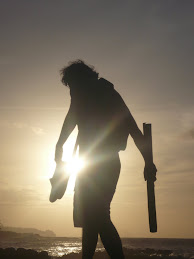A social pattern that Rick Coleman has observed in his work overseas is that of the 'Village Crazyman':
Everywhere he has worked, Rick has encountered this person - typically slightly overweight (ie well-fed), and the only person in his village who is growing anything with any success - often with raging success, while everyone around has written him off as 'crazy'; simply because of the lack of social proof:
If that guy was doing things so right, then why isn't everyone else doing it?
Africa, Peru, Mexico, Palestine, Mongolia; wherever he went, sooner or later he would eventually run into this person, and when he did… it would be time to ask lots of questions & take furious notes… and ironically enough, when Rick returns home to his productive permacultural bio-dome smack-bang in the middle of the declining pastures in Gippsland (considered prime dairy country in that neck of the woods), guess who the neighbors consider to be the crazyman?
Photo: Our new friend Sawi is Da Man!When we first met Sawi during our tour of Ifira Island on Day 1 of this consultancy, it was clear that he was doing some very good things - but it wasn't until we had conducted our site visits to Araki Island & Dixson's Reef that it started to become clear that we had found our 'Crazyman'.
One consequence of the relative material affluence of this small community is a preference for buying cheap, processed & imported foods, and Sawi is one of the few residents of Ifira Island still growing his own food: trained chickens, free-range-non-foraging pigs, cyclone yams (not a typo), fruit & nut trees, hessian-crete walls (hessian bags dipped in concrete and used as a sort of plaster), thermal-efficient roasting oven, handmade fishtraps, compost heaps, nursery operations - he's got a lot going on.
Check out these no-dig garden beds, made from treestumps, compost, & leaf litter, growing 'cyclone yams' (wild yams which can store in the ground for many seasons and can act as a backup food supply in case of cyclones), at least 3 different varieties of Island Cabbage (Abelmoschus manihot, aka Edible Hibiscus), an unidentified shrubby edible, and interplanted with colorful varieties of Coleus to attract beneficial insects:
Photo: No-dig Gardenbeds on Ifira Island in Vanuatu.
Photo: Three different varieties of Island Cabbage (Abelmoschus manihot, aka Edible Hibiscus).
Photo: Mushrooms thriving on the decomposing log borders.

No comments:
Post a Comment